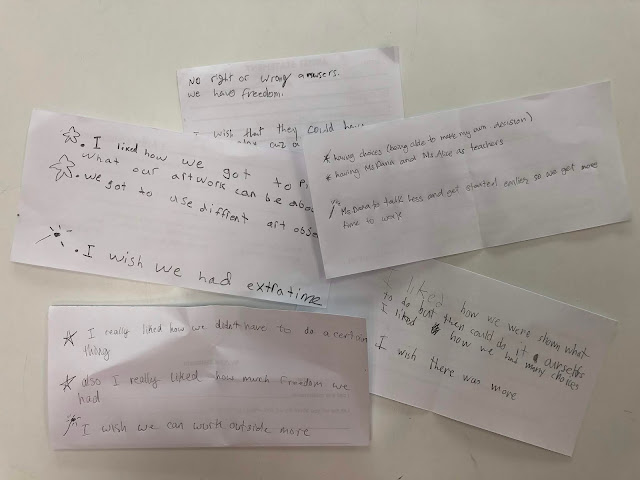Developing Ideas: Guiding Young Artists to Extend and Explore
How does a choice-based classroom allow for student artists to develop their ideas in a meaningful way? This is a question I am currently experimenting with and offering varied solutions for in my PYP art studio.
For the most part, I'm finding that there is no end to the ideas that students want to investigate. However, some of them enter the art studio with so many ideas that they find it difficult to stick with just one. They are enthusiastic, they are motivated, and they want to try it all! They ping pong from here to there, experimenting with one technique, then collaborating on another, engaging in making mistakes, and finding out what they like and don't like as an artist.
I love this about running a choice-based art studio.
However, I also wonder what the limit of these explorations should be? At what point does a student need to choose a topic, medium, or technique and explore it more in depth? What is the role of the teacher in ensuring a level of commitment does occur within each student? Does it matter if a student commits to a long-term idea/project? What is "long-term"?
Seeing the value of short-term explorations and long-term commitments in the art studio, I think it's important for my students to be able to do both. Having understood this about myself, I am in the midst of supporting both artistic skills in the classroom and here's how:
- Using our school's Creative Cycle to make the process visible. Recently, we looked at ISPP's Creative Cycle and students pair/shared what they knew about developing ideas. I asked a few to share and was impressed with their understandings: "It's like a mini-reflection on what you want to do next", "It's a way to grow your ideas bigger and better", "It's using your mistakes to do something different". I emphasized that the "Developing Ideas" stage was not something that you had to stop Creating to do. Often, while you are creating, your brain is developing ideas, directing you towards the next steps of art making. One class decided to think of themselves "dancing the line" between Developing Ideas and Creating throughout the course of a class period.
- Specific classroom examples. I have asked students to be especially aware of when and how they are developing their ideas this week during studio time. We've reflected and shared these moments of developing ideas (big and small) in order to encourage and show others the variety of ways we can take an idea further.
- In the middle of studio time, I've rung a bell, asked students to stop what they're creating and take 2 minutes to complete a "what if" exercise with a partner. This is a quick sharing session where partners see what the other is up to and make a few suggestions for next steps using, "What if..." as a sentence starter. It is up to the artist to take or leave the suggestions, but it might plant a seed of wonder throughout the rest of the studio time. Something as simple as, "What if you added another character to this scene?" or "What if the shape of your painting was a circle?" has allowed students to consider other possibilities for their artworks-in-progress.
- At the end of class, I have been asking students to share a specific time they developed their idea by changing, adding to, extending, recognizing a mistake, or taking a risk. We've recorded and displayed many of these anecdotes for students in other classes to read and connect.
- Reflecting with real world examples. As it is the beginning of the school year and students don't yet have works to display in our school art gallery, "Innovasia", we created a display to show the Creative Cycle in Action! Alice, my TA, and I collected real world examples from students and staff at ISPP of how or when they use the Creative Cycle. I plan to use this display to highlight all parts of the creative process, but thought it might help to give students real world examples of when and why we develop ideas in our daily lives. It was fun for me to hear the connections our school community made to the Creative Cycle and I hope it encourages our students to become active problem solvers throughout their days.
- "Develop Your Idea!" sample board. I created the below bulletin board this week to show students visually how they might think about extending and exploring new possibilities with a any subject matter. For example, I have several students really into unicorns and rainbows right now. I want to encourage their subject matter, but help them to extend the ways they are representing it. Hopefully when they see how the gecko was transformed into 8 more interesting artworks, they might consider taking a risk and exploring creative representations as well!











Comments
Post a Comment